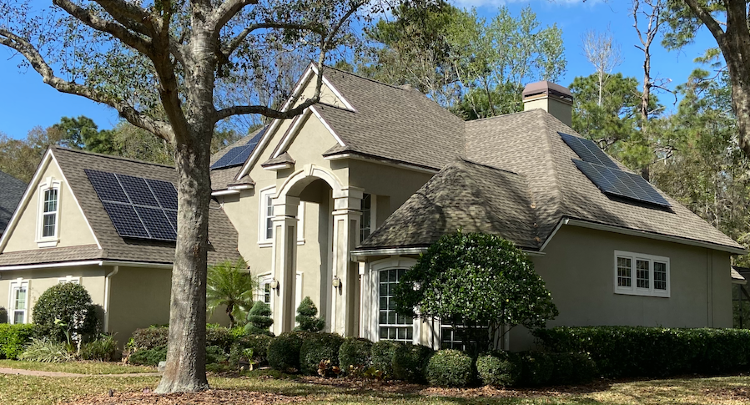We're excited to share another post from Abigail Welborn, who is an Ecological Disciple subscriber, writer, and supporter of Circlewood (our parent organization). In her last column, she shared about greening her family's vehicles. Here she describes her experience with rooftop solar. Enjoy.
When my family first moved to Florida, one of the ways to “go green” that I was most excited about was getting solar panels. Solar panels in the Sunshine State? I thought it would be a no-brainer! The whole project has been more complicated and frustrating than I expected, compared to how easy it was to buy and adjust to, say, an induction cooktop or an electric car.
My biggest and best advice if you’re interested in rooftop solar is to get recommendations from people in your area, especially if you want your investment to pay for itself eventually. Here are some things we learned.

Our Location
The biggest factor in how cost-effective solar panels are is actually… your roof. Our house faces south, which means the flattest part of the roof (where it’s easier to put panels) faces north, which is hardly worth paneling. Fortunately, we still get many hours of sun each year, but we aren’t able to take full advantage of it. We also weren’t willing to get rid of our shade trees, which further reduces our maximum potential generation.
I dream of the day when we will once again architect for the climate instead of building identical houses everywhere and counting on being able to air condition them. (That said, a lot of hot places do have a lot of sunlight.)
Our Utility Company
Our utility doesn’t offer “net metering,” which returns a 1-kWh credit for each kWh that you put into the grid. Instead it pays the wholesale cost, which is lower than the retail price we pay when we pull from the grid. That’s fair, but it does affect how quickly we’ll recoup costs and whether it pays to buy more panels.
You also have to watch the fine print. While every utility company has a flat fee that’s the same for all residential customers, my in-laws installed rooftop solar only to find that their utility also had a “minimum bill” of $25 before taxes. Thus even though they generate more electricity than they use every month, they still have to pay around $29 a month. (Some of that money is recouped at the end of the year when they get paid the wholesale rate for unused credits.)
Our Personal Situation
Your electric usage and your neighborhood can affect how and when you decide to use rooftop solar. Fortunately, our Homeowners Association couldn’t legally prevent us from installing rooftop solar. Our installation company had worked in this area before and handled all the permitting applications for us, which is another reason to ask around for local recommendations.
We decided to get a whole-house battery because it allowed us to get better value for each kW we generate (since we can use the battery overnight and get the “full value” of the electricity, instead of selling back to our utility for just the wholesale rate). It also serves as a backup in case of a power outage—without it, you need special permission and configuration so that you never put electricity into the grid when the grid power is out (we don’t want to electrocute line workers!). But it did add significantly to our cost.
What Was Frustrating
I didn’t make sure that the actual people who installed our system had previously installed the specific configuration quoted by the estimator. As such, installation took longer than it should have and we’ve had multiple problems with settings because the components don’t always play nicely with each other. Sometimes it just means we’re not charging the battery, but a few times it caused our house’s electricity to go out and it took an hour or more on the phone to figure out what went wrong.
To cover all your electricity, you need to know the peak draw at any given time. We have 24 panels rated at 360W each, but because of the orientation of our house, roof, panels, etc., the highest we generate at one time is about 5 kW. Our house very rarely uses more than 3 kW of electricity at one time—except when the clothes dryer sends it up to 9! I didn’t find this out until after the installation. When this happens we simply draw the extra power from the grid, but it means we could never power the dryer with just our solar.[1] This is important for setting your expectations.

Last Thoughts
By the time we installed, we weren’t expecting the system to pay for itself completely; we were just happy to have backup power and to reduce our carbon emissions. In contrast, my in-laws most likely will earn back the lower cost of their no-battery system with net metering.
I’m not sad we got rooftop solar, but it definitely hasn’t been as easy a transition as I hoped. There’s huge potential for off-grid rooftop solar, microgrids, and utility-scale cleaner energy, and someone has to be an early adopter to move the tech forward. Just go in with your eyes open!
Abigail Welborn
Get in touch with Abigail: Twitter or Instagram.
[1] If this peeves you as it does me, you can advocate for more heat pump dryers (also called ventless) to be made available here in the US. They are common in Europe, and yes, they do take longer to dry clothes, just as efficient washing machines and dishwashers use time to make up for using less energy, but it wouldn’t be enough for me to notice. Sadly, the few that are available in the States are too small to be practical for a family with kids—they’re meant for apartments, and that works well—or incredibly expensive. But demand will increase supply! Spread the word!